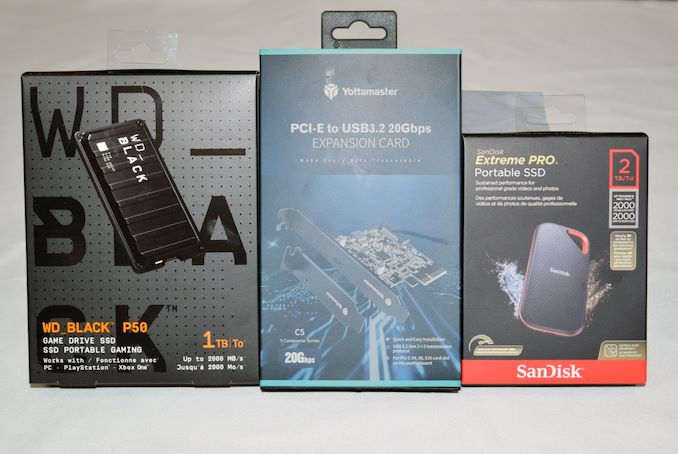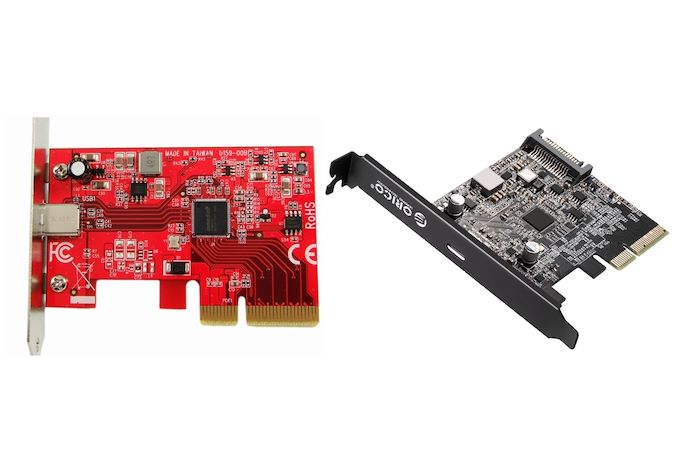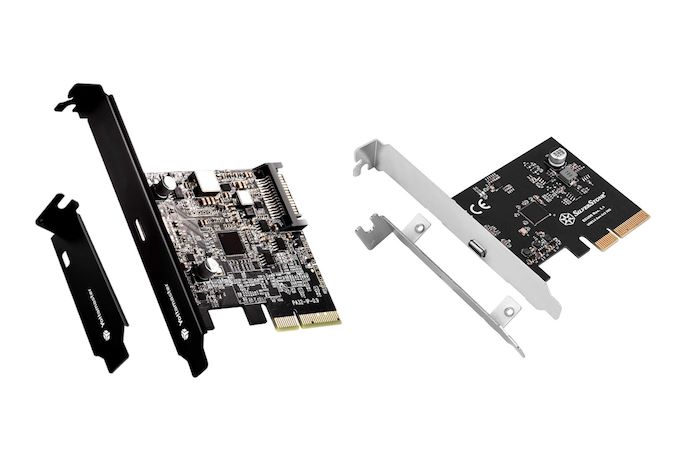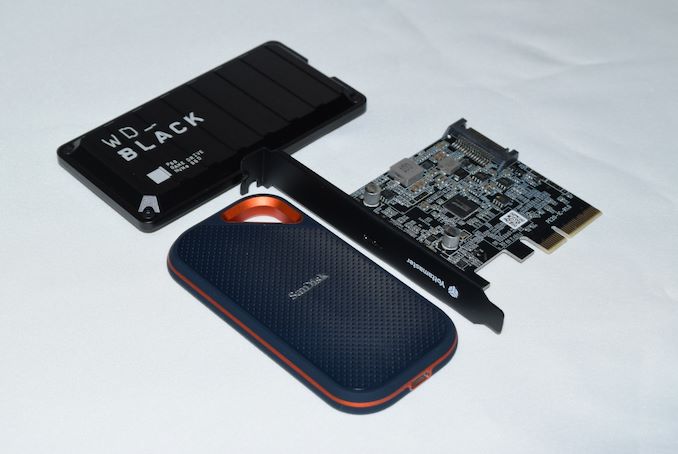USB 3.2 Gen 2x2 State of the Ecosystem Review: Where Does 20Gbps USB Stand in 2020?
by Ganesh T S on October 5, 2020 10:30 AM EST- Posted in
- Storage
- SSDs
- Western Digital
- SanDisk
- ASMedia
- USB 3.2 Gen 2x2

USB has emerged as the mainstream interface of choice for data transfer from computing platforms to external storage devices. Thunderbolt has traditionally been thought of as a high-end alternative. However, USB has made rapid strides in the last decade in terms of supported bandwidth - From a top speed of 5 Gbps in 2010, the ecosystem moved to devices supporting 10 Gbps in 2015. Late last year, we saw the retail availability of 20 Gbps support with USB 3.2 Gen 2x2 on both the host and device sides. Almost a year down the line, how is the ecosystem shaping up in terms of future potential? Do the Gen 2x2 devices currently available in the retail market live up to their billing? What can consumers do to take advantage of the standard without breaking the bank? Western Digital recently launched the SanDisk Extreme PRO Portable SSD v2 with USB 3.2 Gen 2x2 support. A hands-on review of the SSD sets the perfect background for discussing the above aspects.
Introduction
The USB Implementers Forum (USB-IF) has been hard at work in bringing new features into the world of USB - In the last five years or so, we have seen the emergence of Type-C, and multiple updates to the USB standard itself. USB4 has been making a lot of news recently (thanks to its implementation in Intel's Tiger Lake, as well as the fact that Intel lent its high-performance Thunderbolt 3 specifications for USB4). However, this piece deals with the most recent specification update prior to that - USB 3.2 Gen 2x2.
USB 3.2 Gen 2x2 (or SuperSpeed USB 20Gbps) - A Brief History
In mid-2017, USB-IF announced USB 3.2 to bring 20 Gbps bandwidth support to the Type-C ecosystem. Type-C supports two sets of high-speed differential pairs. Only one set is used for traditional 10 Gbps operation (in USB 3.2 Gen 2), with the other set used for supporting alternate modes such as DisplayPort. USB 3.2 Gen 2x2 allows this set also to be used for data transmission (when the alternate modes are not needed). This doubled the available data bandwidth to 20 Gbps. A year down the road, ASMedia demonstrated a PHY for the 2x2 operation. At MWC 2019, USB-IF made public the branding strategy for the the different USB 3.2 flavors - SuperSpeed USB for USB 3.2 Gen 1 ( 5Gbps ), SuperSpeed USB 10Gbps for USB 3.2 Gen 2, and SuperSpeed USB 20Gbps for USB 3.2 Gen 2x2. This was followed by the announcement and demonstration of the ASMedia ASM3242 Gen 2x2 controller for hosts and the ASMedia ASM2364 Gen 2x2 to PCIe (NVMe) controller for devices at Computex 2019. At the same show, Phison also announced a single-chip USB 3.2 Gen 2x2 / NAND flash controller, the PS2251-17.
Premium motherboards with USB 3.2 Gen 2x2 ports built-in started appearing towards the end of 2019 with the introduction of the AMD TRX40 chipset, followed later on by the Intel Z490 boards. All these boards enabled the feature using the ASM3242 controller. Vendors also launched stand-alone PCIe 3.0 x4 expansion cards to equip older PCs with USB 3.2 Gen 2x2 (SuperSpeed USB 20Gbps) ports. On the client devices front, initial demonstrations were carried out with USB 3.2 Gen 2x2 enclosures equipped with PCIe 3.0 x4 M.2 NVMe SSDs. Some of these enclosures have made it to the retail market. Vendors such as Western Digital and Seagate have also released external SSDs supporting the USB 3.2 Gen 2x2 standard in the last 12 months.
Getting into the USB 3.2 Gen 2x2 Ecosystem
Consumers wanting to get into the USB 3.2 Gen 2x2 ecosystem can opt to build a PC with one of the TRX40 or Z490 boards supporting SuperSpeed USB 20Gbps. Building a new PC is only an option for a few - for an interface standard to take off, consumers need to either get the port in an off-the-shelf PC, or, have PCIe expansion cards that can be fitted into older systems. GIGABYTE was one of the first tier-one vendors announce such a card - the GIGABYTE GC-USB 3.2 GEN 2x2. However, the card is yet to become available for retail purchase.

AbleConn PEX-UB159 and the ORICO PE20-1C
The currently available options for adding a USB 3.2 Gen 2x2 port to systems that don't come with one built in are listed below:
- Ableconn PEX-UB159 : $60
- ORICO PE20-1C : $50
- Silverstone ECU06 : AUD 109 (Australia-only)
- Yottamaster C5: $70

Yottamaster C5 and Silverstone ECU06
All these require a spare PCIe 3.0 x4 expansion slot in the computer. An interesting aspect to note is that the Silverstone ECU06 and the AbleConn PEX-UB159 do not require any external power. For reasons we haven't taken the trouble to analyze, the ORICO and Yottamaster cards require external power supplied via a SATA power connector. This could be relevant in systems that do not have a spare SATA power connector (as described in the next section). The Yottamaster C5 and the ORICO PE20-1C both seem to use the same PCB, with just the branding on the bracket being different. Additionally, the PE20-1C product tag is printed on the C5 PCB. This is enough evidence to infer that they are both sourced from the same factory line using the same PCB design.
On the device side, one of the most economical ways to adopt USB 3.2 Gen 2x2 remains the purchase of an appropriate enclosure and a compatible SSD:
- IOCrest / Syba SY-ENC40231 : $66
- ORICO M2PAC3-G20
- Yottamaster Y-Hybercube HC2 : $90
Coupling any of the above with a high-end NVMe SSD like the SK Hynix P31 (1TB / $135) or WD Black SN750 (1TB / $150, or 2TB / $310) should result in a speedy SuperSpeed USB 20Gbps external SSD for around 20¢/GB. Note that the SSDs mentioned here are specifically those that consistently maintain 1.5 GBps+ direct-to-TLC writes without a significant price premium.
The easier way out is to purchase an off-the-shelf external SSD. There are three options currently in the market, specified here in the order of retail availability date:
- Western Digital's WD_BLACK P50 (500GB @ $134, 1TB @ $232, and 2TB @ $350)
- Seagate's FireCuda Gaming SSD (500GB @ $200, 1TB @ $271, and 2TB @ $485
- Western Digital's SanDisk Extreme PRO Portable SSD v2 (2TB @ $380)
The SanDisk Extreme PRO Portable SSD v2 line will also have a 1TB model, but that will not be available in retail until later this year.
Unless one moves to the high-end of the capacity line with the 2TB models, the cost-per-GB metric (above 20¢ per GB) is simply not competitive against the SuperSpeed USB 10Gbps external SSDs that have taken over the market in the last couple of years. At the 2TB capacity point, excellent external SSDs of this type are available at less than 15¢ per GB, while the best that the above three families can offer is 0.175¢ per GB. As adoption increases, the price should go down, but right now, there is no denying that there is a premium. Is the premium worth it? We review selected components from the above list in an attempt to find the answer.
The Test Devices
Western Digital had sampled a review unit of the WD_BLACK P50 (1TB version) earlier this year, but I had placed it at the bottom of my review queue for a couple of reasons. For starters, none of our direct-attached storage testbeds were SuperSpeed USB 20Gbps-capable. The other reason was that the WD_BLACK P50, despite its wide retail launch, appeared to be more of a technology-demonstration product, with the ecosystem for SuperSpeed USB 20Gbps still in its infancy. Last month, Western Digital doubled down on targeting the USB 3.2 Gen 2x2 device market with the launch of the SanDisk Extreme PRO Portable SSD v2. A review sample was also supplied along with the SanDisk Extreme Portable SSD v2, which was analyzed in detail last week.
Having two Gen 2x2 devices in hand, we felt that the standard was gaining market traction. To get started with the review, we reached out to a couple of the aforementioned expansion card manufacturers, and Yottamaster was the first to respond with a retail sample of the C5 expansion card.
The rest of the review details the steps taken to set up an appropriate testbed for evaluation of USB 3.2 Gen 2x2 devices, followed by a discussion of the features and characteristics of the WD_BLACK P50 and the SanDisk Extreme PRO Portable SSD v2. A look at the performance numbers for various workloads - both synthetic and real-world, as well as accelerated playback of access traces - is provided. As customary, we also explore the worst-case consistency for typical DAS workloads, thermal performance and power consumption numbers. In the last section, we provide some concluding remarks while touching upon the outlook for the USB 3.2 Gen 2x2 (SuperSpeed USB 20Gbps) standard.











81 Comments
View All Comments
Eric_WVGG - Tuesday, October 6, 2020 - link
On a related note, I would love to see you guys do some kind of investigation into why we're five years into this standard and one still cannot buy an actual USB-C hub (i.e. not a port replicator).hubick - Tuesday, October 6, 2020 - link
A 3.2 hub with gen 2 ports and a 2x2 uplink would be cool!I wanted a 10gbps / gen 2 hub and got the StarTech HB31C3A1CS, which at least has a USB-C gen 2 uplink and a single USB-C gen 2 port (plus type A ports). Don't know if you can do any better than that right now.
repoman27 - Tuesday, October 6, 2020 - link
Although it's still not exactly what you're looking for, I've tried (unsuccessfully) to get people to understand what a unicorn the IOGEAR GUH3C22P is. Link: https://www.iogear.com/product/GUH3C22PIt's a 5-port USB3 10Gbps hub with a tethered USB Type-C cable on the UFP (which supports up to 85W USB PD source), two (2!) downstream facing USB Type-C ports (one of which supports up to 100W USB PD sink), and two USB Type-A ports (one of which supports up to 7.5W USB BC).
serendip - Thursday, October 8, 2020 - link
No alt mode support like for DisplayPort. I haven't found a portable type-C hub that supports DisplayPort alt mode over downstream type-C ports although some desktop docks support it.stephenbrooks - Tuesday, October 6, 2020 - link
What if I want a USB 20Gbps port on the front of my computer?Can I get a USB-C front panel and somehow connect the cable internally to the PCI-E USB card?
abufrejoval - Tuesday, October 6, 2020 - link
I am building hyperconvergent clusters for fun and for work, the home-lab one out of silent/passive 32GB RAM, 1TB SATA-SSD J5005 Atoms, the next iteration most likely from 15Watt-TDP-NUCs, an i7-10700U with 64GB RAM, 1TB NVMe SSD in testing.Clusters need short-latency, high-bandwidth interconnects, Infiniband is a classic in data centers, but NUCs offer 1Gbit Ethernet pretty much exclusively, Intel struggling to do 2.5Gbit there while Thunderbolt and USB3/4 could do much better. Only they aren’t peer-to-peer and a TB 10Gbase-T adapter sets you back further than the NUC itself, while adding lots of latency and TCP/IP, while I want RDMA.
So could we please pause for a moment and think on how we can build fabrics out of USB-X? Thunderbolt/USB4 is already about PCIe lanes, but most likely with multi-root excluded to maintain market segmentation and reduce validation effort.
I hate how the industry keeps going to 90% of something really useful and then concentrating on 200% speed instead of creating real value.
repoman27 - Wednesday, October 7, 2020 - link
Uh, Thunderbolt and USB4 are explicitly designed to support host-to-host communications already. OS / software support can be a limiting factor, but the hardware is built for it.Existing off-the-shelf solutions:
https://www.dataonstorage.com/products-solutions/k...
https://www.gosymply.com/symplyworkspace
https://www.areca.com.tw/products/thunderbolt-8050...
http://www.accusys.com.tw/T-Share/
IP over Thunderbolt is also available:
https://thunderbolttechnology.net/sites/default/fi...™%20Networking%20Bridging%20and%20Routing%20Instructional%20White%20Paper.pdf
https://support.apple.com/guide/mac-help/ip-thunde...
repoman27 - Wednesday, October 7, 2020 - link
Stupid Intel URL with ™ symbol. Let's try that again:https://thunderbolttechnology.net/sites/default/fi...
abufrejoval - Wednesday, October 7, 2020 - link
Let me tell you: You just made my day! Or more likely one or two week-ends!Not being a Mac guy, I had completely ignored Thunderbolt for a long time and never learned that it supported networking natively. From the Intel docs it looks a bit similar to Mellanox VPI and host-chaining: I can use 100Gbit links there without any switch to link three machines in a kind of “token ring” manner for Ethernet (these are hybrid adapters that would also support Infiniband, but drivers support is only support Ethernet for host-chaining). Unfortunately the effective bandwidth is only around 35GByte/s for direct hops and slows to 16GByte/s once it has to pass through another host: Not as much of an upgrade over 10Gbase-T as you’d hope for: I never really got into testing latencies, which is where the Infiniband personality of those adapters should shine.
And that’s where with TB I am hoping for significant improvements over Ethernet apart from native 40Gbit/s speed: Just right for Gluster storage!
I also used to try to get Ethernet over fiber-channel working years ago, when they were throwing out 4Gbit adapters in the data center, but even if it was specified as a standard, Ethernet over fiber never got driver support and at the higher speeds the trend went the other direction.
So I’ll definitely try to make the direct connection over TB3 work: CentOS8 should have kernel support for TB networking and the best news is that it doesn’t have to wait for TB4, but should work with TB3, too.
I’ve just seen what seemed like an incredibly cheap 4-way TB switch recommended by Anton Shilov on the TomsHardware side of this enterprise, which unfortunately is only on pre-order for now (https://eshop.macsales.com/shop/owc-thunderbolt-hu... but supposed to support TB networking. Since the NUCs are single port TB3 only, that should still do the trick and be upgradable to TB4 for just around $150… The 5Gbit USB3 Aquantia NIC wasn’t much cheaper and even the 2.5Gbit USB3 NIC are still around $40.
Exciting, exciting all that: Thank you very much for those links!
abufrejoval - Wednesday, October 7, 2020 - link
...except... I don't think that "switch" will be supporting multiple masters, same as USB.If it did, Intel would have shot themselves in the foot: 40Gbit networking on NUCs and laptops with little more than passive ables, that's almost as bad as adding a system management mode on 80486L and finding that it can be abused to implement a hypervisor (Mendel and Diane started VMware with that trick).
Yet that's exactly what consumers really thirst for.